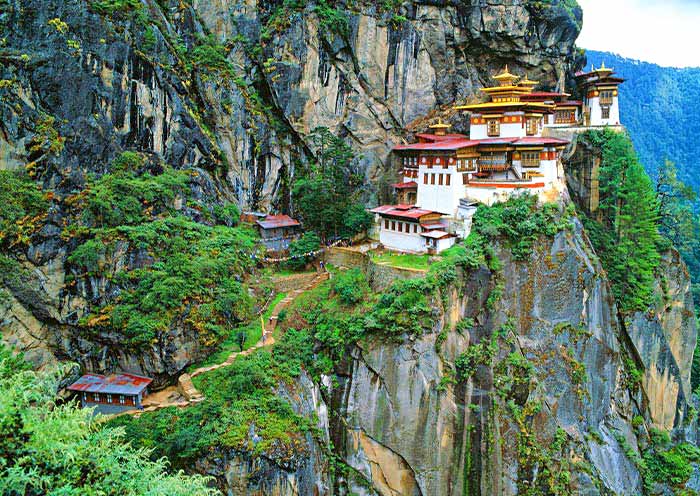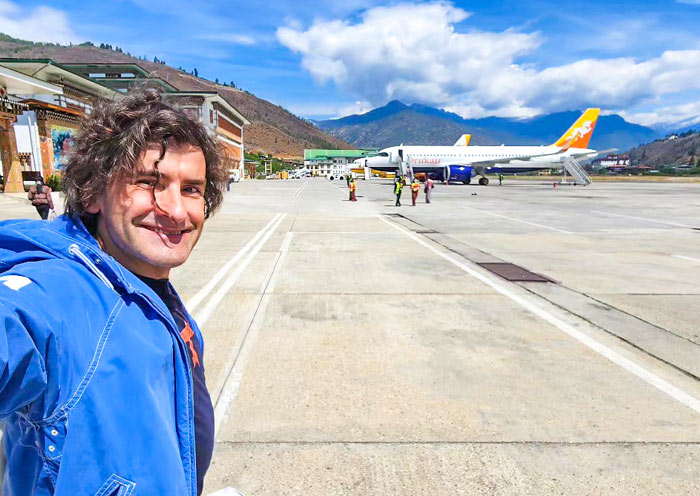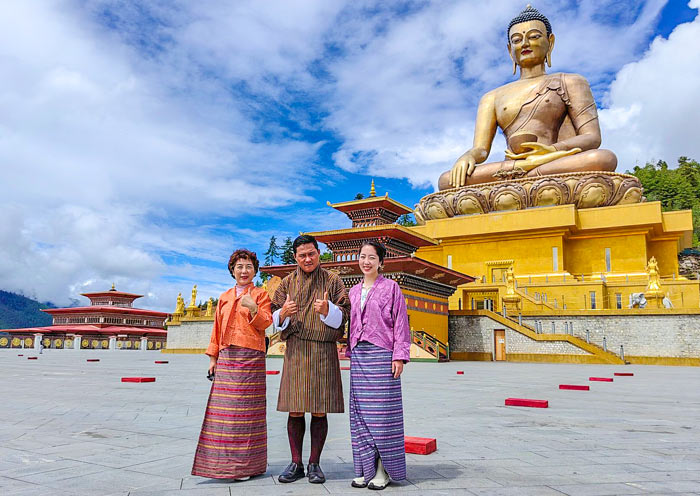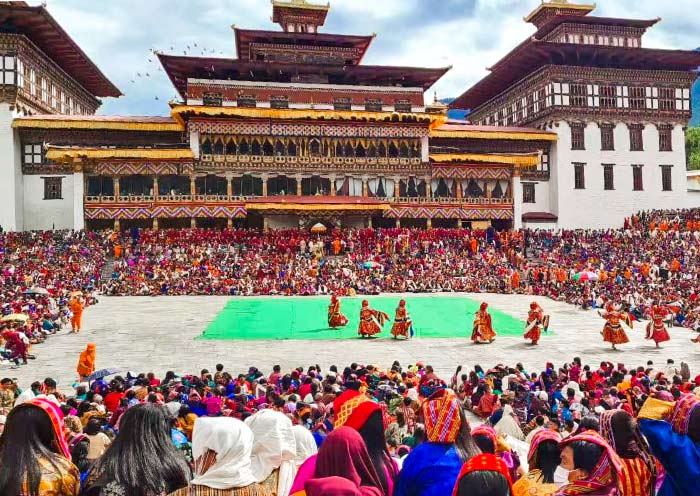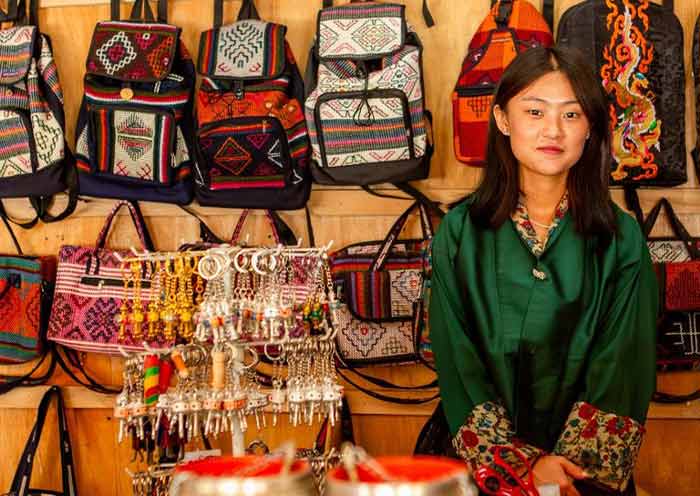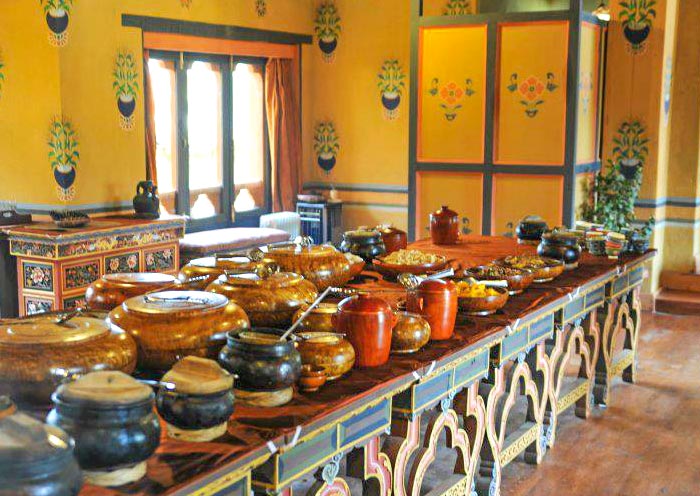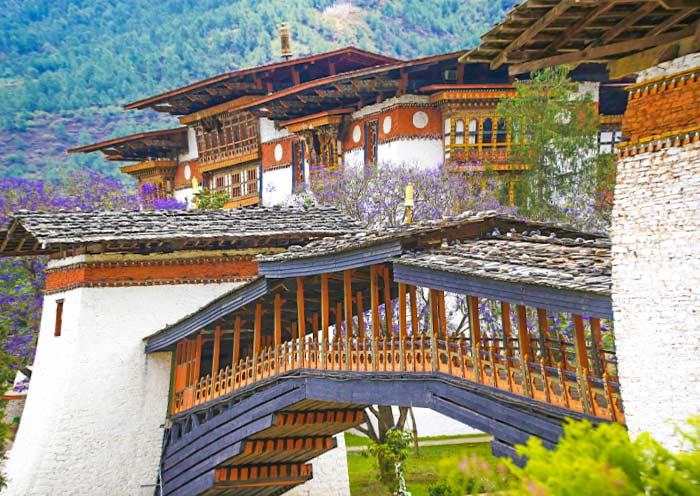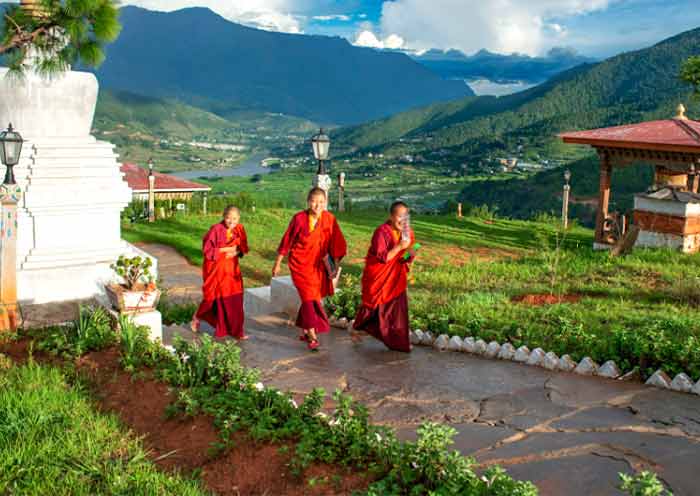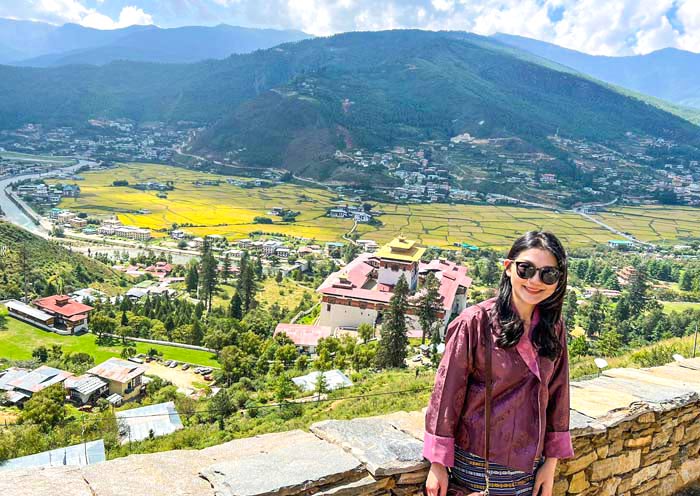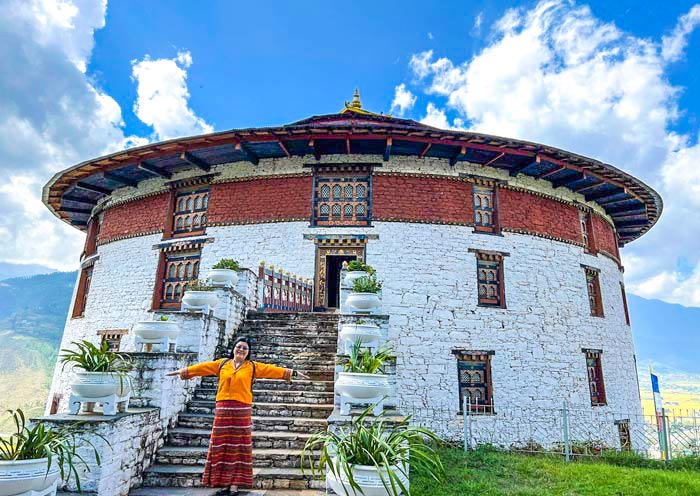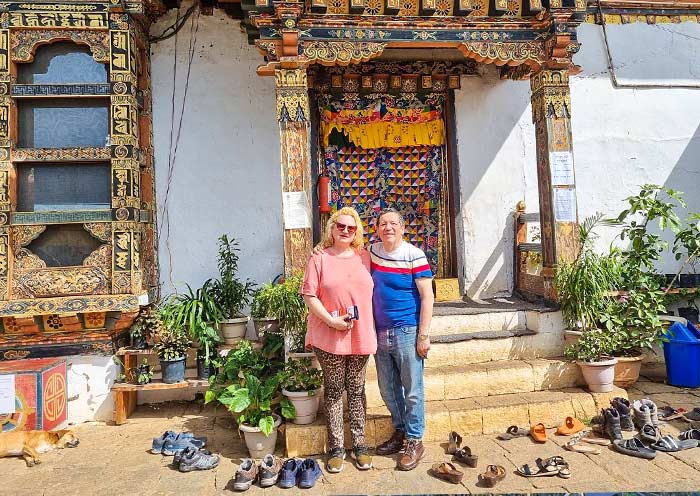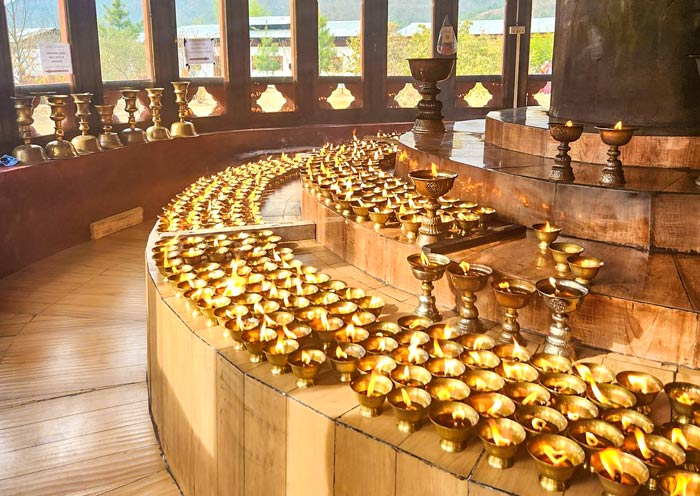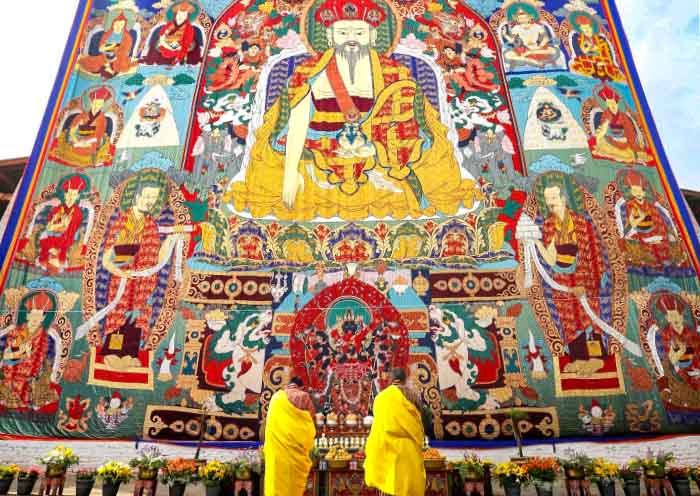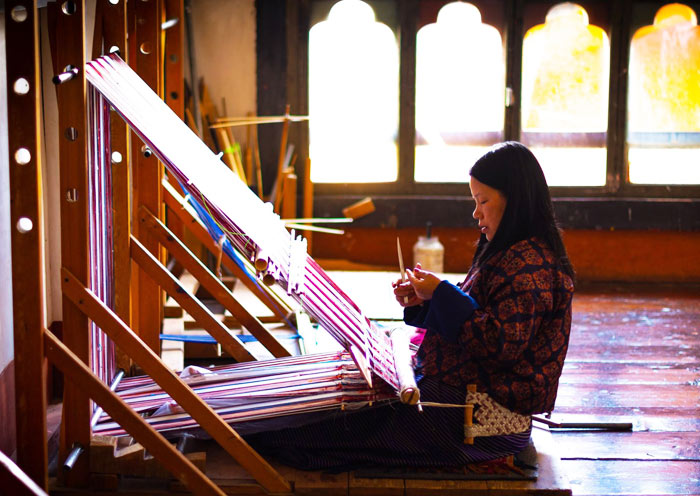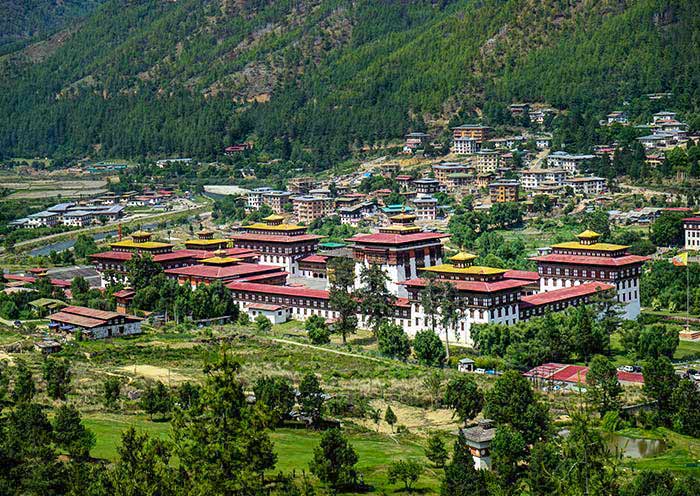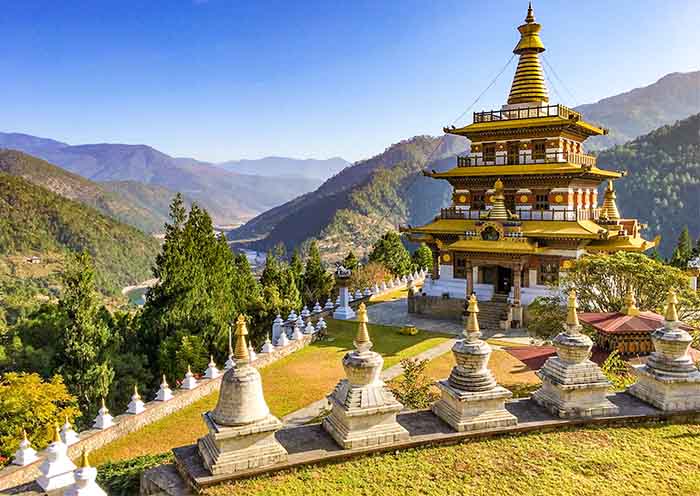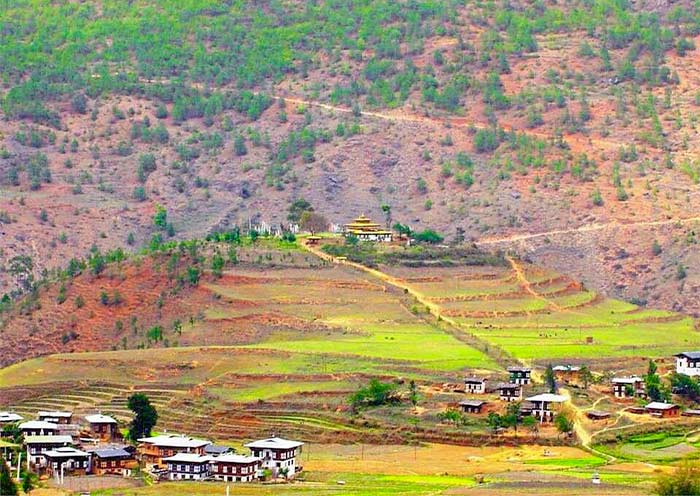Punakha lies in a warm, fertile, and stunningly beautiful valley at the confluence of the Mo Chhu (Mother River) and Pho Chhu Rivers (Father River). Commanding the river junction is the gorgeous Punakha Dzong, perhaps Bhutan’s most impressive building. Today, you will first visit Punakha Dzong, which is arguably the most beautiful dzong in the country, especially in spring when the lilac-colored jacaranda trees bring a lush sensuality to the dzong’s characteristically towering whitewashed walls. Occasionally, you'll spot monks draped in red robes passing by, occasionally echoing rhythmic sounds of their chanting and prayer.
Punakha Dzong, the second oldest and second largest Dzong in Bhutan serving administrative and monastic functions holds a legendary tale. It is said that Guru Rinpoche (Padmasambhava) prophesied the arrival of a person named Namgyal built a Dzong on a hill resembling an elephant. In 1637, Shabdrung Ngawang Namgyel, the unifier of Bhutan, received a divine vision guiding him to construct a Dzong at this site. The Dzong was played as the administrative center and the seat of the Bhutanese officials till the capital city was moved from Punakha to Thimphu in 1955. All of Bhutan’s kings have been crowned here and In 2011, the Dzong bore witness to the royal wedding ceremony of His Majesty Jigme Namgyel Wangchuck, the 5th King of Bhutan, as he married Queen Jetsun Pema. Now, the Dzong serves as the winter residence for Je Khenpo (head abbot of Bhutan), as well as about 1,000 monks.
After crossing the Bazam Bridge, you can walk inside the Punakha Dzong and take your time to admire this stunning example of Bhutanese Dzong architecture which was built of stone, pounded mud, and a considerable amount of timber (without nails, written plans, or designs). There is a six-story central tower called utse standing in the yard of the Punakha Dzong. As the highest architecture within the Dzong, utse houses the most sacred temples and shrines and contains important religious artifacts, thangkas, statues, and texts. This Dzong has three docheys (courtyards) instead of the usual two. The first (northern) courtyard is for administrative functions and houses a huge white Victory Chorten and Bodhi tree. The second courtyard houses the monastic quarters and is separated from the first by the utse. In this courtyard, there are two halls; one of Ugyen Wangchuck (the King of Bhutan) and another hall where the King was decorated in 1905 with the Order of the Knight Commander of the Indian Empire by John Claude White. In the third (southernmost) courtyard is the temple where the remains of the Pema Lingpa (a treasure revealer, Five Terton Kings) and Shabdrung (founder of Tshechu Festival and Bhutan National Dress) are preserved. At the south end, there is the kunrey, or "hundred-pillar" assembly hall with exceptional murals that depict the life of Buddha. If you visit during the Punakha Tshechu Festival, you can enjoy the mesmerizing masked dances and witness the exhibition of a large thangka depicting the Zhabdrung (Shabdrung, the father of Bhutan) once a year. You can have fun with locals who flood here dressed in Bhutan’s national attire, with men wearing Gho and women wearing Kira. Optional activity: You have options to go rafting in the Po Chu and Mo Chu rivers, offering unique views of the Dzong not possible from land.
After exploring the Punakha Dzong, your journey continues with an opportunity to cross one of Bhutan’s longest pedestrian suspension bridges over the Po Chhu River. By walking across this 160-meter suspension bridge, you will be treated to breathtaking views of the lush Punakha Valley and the glacier-fed Po Chhu River below. Upon crossing the bridge, you will walk alongside terraced rice paddies and up a trail to Khamsum Yulley Namgyal Chorten, perched on a beautiful ridge above the Punakha valley. It should take an hour or less to reach the chorten.You may see farmers working the fields by hand or with the assistance of an ox and plow.
The Khamsum Yulley Namgyal Chorten (Stupa) was built in 1990 by the Queen Mother, Ashi Tsering Yangdon Wangchuck, who is the mother of the 5th King Jigme Khesar Namgyel Wangchuck. The purpose of its construction was to ward off evil forces and bring peace to Bhutan and the world. Unlike typical stupas, the Khamsum Yulley Namgyal Chorten is dedicated to the protective deities in Bhutanese culture. Each floor of the chorten pays tribute to different protective deities. This chorten exemplifies a harmonious blend of Bhutanese art, architecture, and traditions. It took Bhutanese carpenters, painters, and sculptors 9 years to complete this distinctive Bhutan-style pagoda. Inside Khamsum Yulley, you can admire the sculptures, and as you continue climbing the steep stairs, you will reach the top level. From there, you can venture onto the roof of Khamsum Yulley Namgyal Chorten and enjoy expansive views of the Punakha. The landscape undergoes a dramatic transformation with the changing seasons, with lush green rice paddies in the summer transforming into captivating golden fields in the autumn.
Then, pay a visit to Sangchhen Dorji Lhuendrup Nunnery. Situated on the summit of a 1,550-meter hilltop, the nunnery offers a breathtaking view of the Punakha valley and Wangduephodrang valley. Surrounded by lush green pine forests, this nunnery complex provides an opportunity to immerse yourself in the monastic way of life and participate in spiritual retreats. Initially established as a Buddhist college for nuns, the nunnery currently houses around 120 nuns. The complex also includes a meditation center dedicated to the nuns. In addition to religious education, the center focuses on teaching practical skills such as tailoring, embroidery, sculpting, and Buddhist Thangka painting. You will have the chance to closely observe and learn about the spiritual lives practiced by the nuns. Within the complex, there is a temple that showcases a magnificent 14-feet bronze statue of Avalokiteshvara, also known as Chenrezig, featuring 1,000 hands and 1,000 eyes. The statue, claimed to be the largest in the country, was meticulously handcrafted by local Bhutanese artisans. Alongside this remarkable statue, the temple also houses other significant statues, including Guru Padmasambhava (Guru Rinpoche), Buddha, Zhabdrung Ngawang Namgyal, the 21 Taras, and the Buddha of longevity.
Overnight in Punakha and get ready for your next day's trip.


